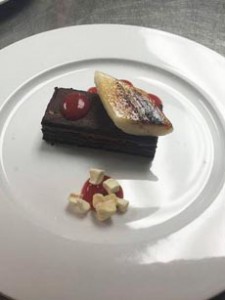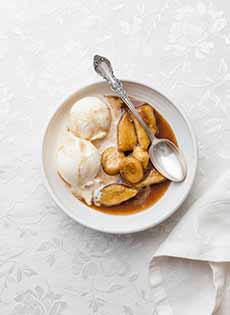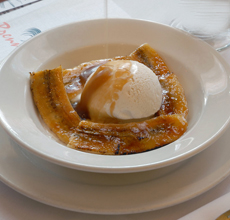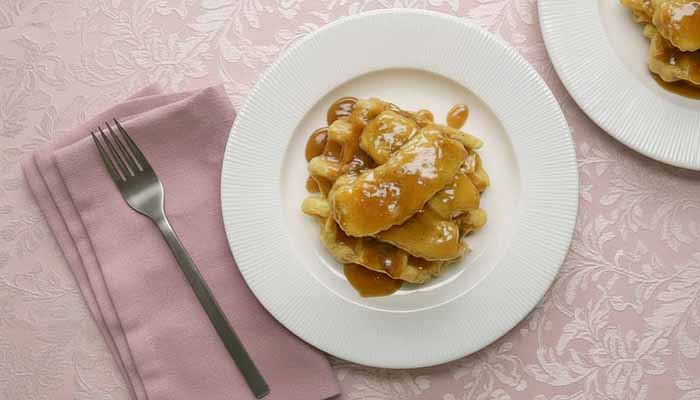Bananas Foster Recipe: Use It As A Topping & Garnish
|
As a lover of both chocolate cake and Bananas Foster, we were inspired by the creative use of Bananas Foster at Davio’s Italian Steakhouse in Boston (see photo). It’s traditionally used to top ice cream.
It’s a most delicious addition. At Davio’s, a slice of flourless chocolate cake is topped with a slice of caramelized banana. But you can adapt the idea to almost any dessert. A chocolate base (or other dark color) is best to contrast the beige banana; but it will be delectable on anything. (It was a hit at THE NIBBLE on top of homemade chocolate pudding.) But first, for your consideration: > The history of bananas and the year’s 10 banana holidays. > America’s favorite banana dishes. And a bit more culinary history… Bananas Foster is a more elaborate version of caramelized bananas. Sliced bananas are sautéed in butter with brown sugar, banana liqueur and Grand Marnier (orange-infused brandy) or rum. It is then flambéed at the table for a dramatic effect, and spooned over vanilla ice cream. For the flame-averse: While igniting the dish tableside is dramatic both at a restaurant and at home, it isn’t necessary. The original Bananas Foster recipe was created in 1951 by Paul Blangé (1900-1977), the executive chef at Brennan’s in New Orleans. The dish was named in honor of Richard Foster, a regular customer and friend of restaurant owner Owen Brennan, Sr. It is one of the flambé desserts that also include Crêpes Suzette and Cherries Jubilee. Savory dishes are also flamed at the table, from Steak Diane to Veal Marsala. Here’s a list of flambé recipes. Note, though, that the technique has long gone out of style. But how did it come into style? |
|
|
|
THE MODERN HISTORY OF FLAMBÉ FOOD Flambé (it means flamed in French), is a cooking procedure in which alcohol is warmed and then added to a hot pan, where it is lit to create a burst of flames. The alcohol burns off shortly and the flames die out. While the practice of igniting food for dramatic flair can be traced to 14th century Moors, modern flambéing became popular only in the late 19th century, and by accident. According to his memoir, in 1895 at the Café de Paris in Monte Carlo, 14-year-old Henri Charpentier (1880-1961), an assistant waiter, accidentally set fire to the liqueur in the pan of crêpes he was preparing. At the time, many foods were prepared tableside. The guests happened to be Albert Edward, the Prince of Wales (the future King Edward VII) and some friends. According to the memoir: “It was quite by accident as I worked in front of a chafing dish that the cordials caught fire. I thought I was ruined. The Prince and his friends were waiting. How could I begin all over? I tasted it. It was, I thought, the most delicious melody of sweet flavors I had every tasted. I still think so. That accident of the flame was precisely what was needed to bring all those various instruments into one harmony of taste.” The dish was served, and the Prince liked it. “He ate the pancakes with a fork; but he used a spoon to capture the remaining syrup. He asked me the name of that which he had eaten with so much relish. I told him it was to be called Crêpes Princesse. He recognized that the pancake controlled the gender and that this was a compliment designed for him; but he protested with mock ferocity that there was a lady present. She was alert and rose to her feet and holding her little skirt wide with her hands she made him a curtsey. ‘Will you,’ said His Majesty, ‘change Crêpes Princesse to Crêpes Suzette?’ Thus was born and baptized this confection, one taste of which, I really believe, would reform a cannibal into a civilized gentleman. The next day I received a present from the Prince, a jeweled ring, a panama hat and a cane.” ___________________ SOURCE: Life A La Henri – Being The Memories of Henri Charpentier, by Henri Charpentier and Boyden Sparkes, The Modern Library, New York, 2001 Paperback Edition. Originally published in 1934 by Simon & Schuster, Inc. Thanks to What’s Cooking America for the reference. |
||
|
|
RECIPE: BANANAS FOSTER TOPPING & GARNISH While the Davio’s recipe cuts the banana into a stylish oblong and the photo at right halves the fruit banana-split style. At Brennan’s the long slices are cut in half. We prefer chunks perhaps 3/4-inch thick—easier to spoon over ice cream…and French toast, pancakes and waffles. Ingredients For 4 Servings zest 1. CUT the bananas in half lengthwise and crosswise for a total of 4 pieces each (alternative: cut 3/4″ rounds; you’ll have more than 4 pieces). 2. MELT the butter in a large skillet over medium heat. Add the brown sugar and cinnamon and cook, stirring until the sugar dissolves (about 2 minutes—this creates a caramel sauce). Add the bananas and cook on both sides until they begin to soften and brown (about 3 minutes). 3. ADD the banana liqueur and stir to blend into the caramel sauce. |
|
|
If you want to flambé, follow the instructions below. However, the drama of the flambé works only if the dish is prepared tableside. Otherwise, the drama is lost in the kitchen. 4. LIFT lift the bananas carefully from the pan and top the four dishes of ice cream; then spoon the sauce over the ice cream and bananas and serve immediately. Here’s a video on how to flambé from QVC chef David Venable. Tips: CHECK OUT WHAT’S HAPPENING ON OUR HOME PAGE, THENIBBLE.COM. |
||







